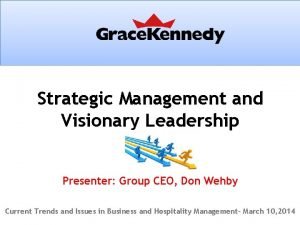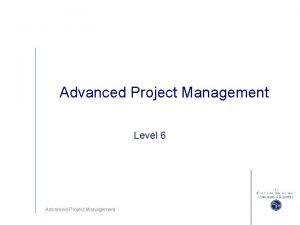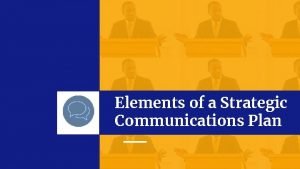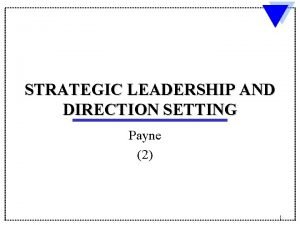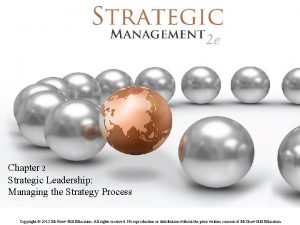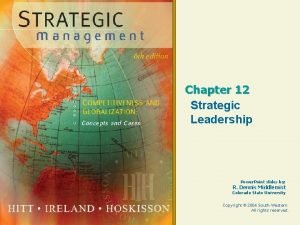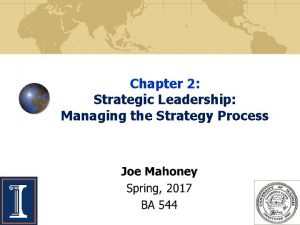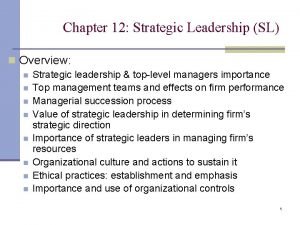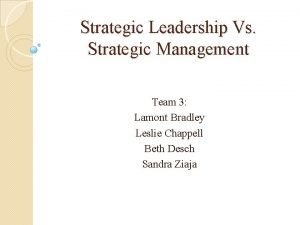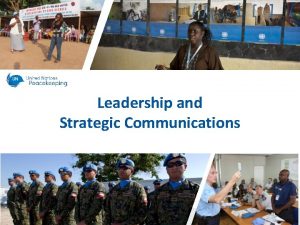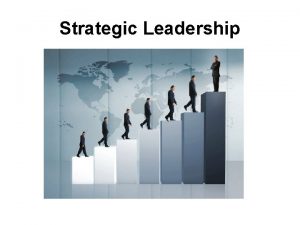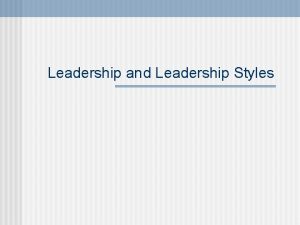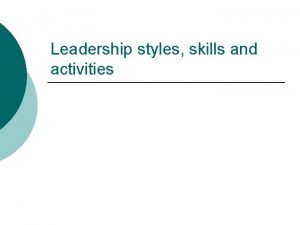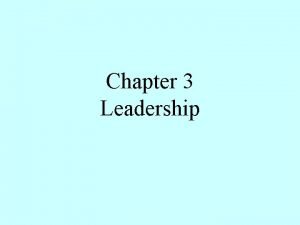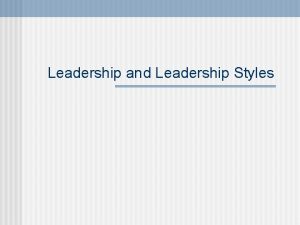Leadership and Strategic Communications 1 Strategic communications in


















- Slides: 18

Leadership and Strategic Communications 1

Strategic communications in Peacekeeping “A comprehensive effort to understand engage key audiences to create, strengthen, or maintain conditions favourable for the advancement of the mission’s interests, policies and objectives through the use of coordinated programmes, plans, themes, messages, and products that employ images, actions and words to achieve a desired and measurable effect through a variety of channels. ” 2

Strategic Considerations for Leadership • Peacekeeping is political • Critical importance of credibility and perception of impartiality • Mission critical activity/Core leadership function • Acts as a force multiplier • Costs of failure to communicate • Expectation management 3

STRATEGIC COMMUNICATION: Core business, really…. The Why: Peacekeeping leadership needs to communicate: 1. Strategic Communications is a central component of a successful UN engagement; 2. The communications revolution has fundamentally changed how the UN’s main audiences expect to receive information, and; 3. It is a command responsibility for UN leadership to oversee and direct this capacity. 4

STRATEGIC COMMUNICATION: “The Why” pt. 2 • Explains role; manages expectations • Establishes and maintains credibility • Improves situational awareness; helps understand threats • Secures consent, builds trust • Encourages cooperation and partnerships • Promotes mission security • Maintains political (and material!) support 5

Mission Public Info & Strat Comms Functions (Spokesperson) Strategic Communications plan Public advocacy Crisis communications Media Relations Press Briefings Media capacity building Media monitoring @UNPeacekeeping (PI & Other Components) (Multimedia) Radio, Video, Web, Print, Photo Outreach Civic education External communications Special programmes STRATEGIC GUIDANCE: SRSG – with advice from SMT, including CPIO 6 Mission Personnel (CPIO)

SOCIAL MEDIA: The New Reality No longer optional… 7 • 4. 2 billion of 7. 6 billion are online • 2. 1 billion are on Facebook; 1 billion on Instagran; 1. 5 bil; 325 mil+ • Amnesty International twitter followers: 500, 000+ • UN Google+ followers: 2 million+ • Coca Cola Facebook update receivers: 90 million • Average time 2 hrs a day • UN Peacekeeping--800, 000 across 7 platforms, 1: 2 ratio M/W, 76% youth (13% growth over last year, 225% growth in IG) • Net sentiment 55. 9% (up from 45% last year); 15% Positive, 4% Negative (13% last year); 81% Neutral

Social media – UNICEF global channels The visit of K-pop group BTS at the UN General Assembly to promote the launch of Generation Unlimited broke several records on UNICEF's global Twitter account: 3 rd most engaging and viewed video posts on the UNICEF global Twitter channel of all time. UNICEF tweets between 23 and 29 September received over 59. 8 million impressions, 5. 4 million engagements and 14. 8 million video views. 4. 9 K comments 8 201 K retweets 485 K likes

But…SERIOUS BUSINESS…tread carefully • Deceptively simple; no clear guidance; seductively easy way to “get the message out” • Requires constant monitoring • Needs dedicated attention, analysis and knowledge of the audience • Know why you are using social media • Platforms are channels, not every channel is right for you • What is your objective? – Give lifesaving information? Break news? Counter disinformation? Dispel rumour? Respond to criticism? Start a conversation? – Influence behaviour? Reassure? Threaten? • What are the potential unintended consequences? • Be prepared for the response and follow-up. 9

Leadership Strat. Comms Functions 1. 2. 3. 4. 5. 6. 7. 10 Media relations Crisis communications Communications campaigns and advocacy Digital media Outreach and publicity materials Multimedia production and Internal communications

Messaging, messaging… (1) Active and advocacy-driven social media presence; (2) Promoting a proactive, candid and nondefensive style of public interaction; (3) Two-way, dialogue-driven approach; (4) Effective internal communications. Two-way communication assessing public perceptions media monitoring/feedback anticipate questions/controversies/opportunities timely response – importance of web-based and international broadcast media in shaping stories and opinion • engage with, listen to national mission personnel • • Targeted content, different audiences • • • 11 current, timely, relevant, credible clear messaging, editorial line information vs. propaganda factual, mandate-driven nuanced but understandable tailored to audiences; special attention to key actors/audiences - women, youth, opinion leaders

Dissemination--Harmony, not duplication Let a thousand flowers bloom (as long as they are on script!) Multiple UN voices • • All mission personnel: uniformed and non-uniformed UN Country Team SRSGs, Envoys, Special Rapporteurs Electoral Multiple platforms/levels • • • 12 MHQ Regional, Sector and local offices UNHQ OHCHR UNCT

Strategic communication approach Outreach, audiences and influence • Multiple audiences, multiple channels (Stakeholders) – In-country o Elites—political, religious, cultural; spoilers; populations –women, youth, combatants, IDPs and other vulnerable groups; media; humanitarians; – Regional o Influential neighbours: Governments; key figures; organizations – Diaspora: expatriates, exiles and refugees – International o Security Council, TCCs/PCCs, influential actors o Decision makers q Government, parliamentarians o Opinion makers / leaders q International NGOs and advocates – “Internal” o All categories, levels of mission personnel and UNCT 13

Leadership considerations: expectations management and crisis communications Be proactive Don’t oversell or obfuscate Brief early, brief often Ensure internal communication (including HQ) • Clear and predictable channels of communications • • 14

The “How”: Craft a core narrative and a master messaging with clear objectives taken from the mission’s foundational documents; (2) Design harmoized sub-messaging designed to reach previously identified key stakeholders and audiences; (3) Diversify message delivery using a variety of channels tailored for the target groups, and: (4) Ensure regular measurement of effectiveness and adjustment of messaging to match evolving realities on the ground. The 6 Ms • Mainstream with strategic communications featured from planning phase throughout policy decision making • Modernize with two-way conversations and new technologies • Merge with existing resources and assets • Manage with clear roles and responsibilities • Measure with data-driven analytics • Message with a core narrative that can be thematic or issue-specific (campaigning) 15

Modern Peacekeeping leaders… 1. 2. 3. 4. 5. 16 Understand that communicating in a timely and purposeful manner is an intrinsic part of the mission’s core business; Oversee the creation and implementation of a mission wide communications strategy that defines key audiences and sets measurable objectives; Ensure the regular data-driven review and adjustment of both goals and activities and requires reporting on accomplishments; Embrace throughout a two-way style of communication that creates dialogue, generates engagement and increases situational awareness (and thus promotes staff and mission security) and: Protect the image and reputation of the mission and the Organization, which speaks to a central UN comparative advantage — credibility and legitimacy.

DPO’s communication priorities Strategic communications to support political objectives § Essential to maintaining support for A 4 P § Valuable as means to explaining objectives of A 4 P § Critical to demonstrating implementation and impact of A 4 P 17

ﺷﻜﺮﺍ 謝謝 thank you merci спасибо gracias 18
 Transactional leadership vs transformational leadership
Transactional leadership vs transformational leadership Visionary leadership and strategic management
Visionary leadership and strategic management Project context
Project context What is adaptive leadership theory
What is adaptive leadership theory Enthusiastic beginner disillusioned learner
Enthusiastic beginner disillusioned learner Single overarching communication outcome
Single overarching communication outcome Strategic communications ku
Strategic communications ku Strategic complement
Strategic complement Io model strategic management
Io model strategic management Strategic analysis and choice in strategic management
Strategic analysis and choice in strategic management Strategic leadership
Strategic leadership Level 5 pyramid of strategic leadership
Level 5 pyramid of strategic leadership Key strategic leadership actions
Key strategic leadership actions Level 5 pyramid of strategic leadership
Level 5 pyramid of strategic leadership Key strategic leadership actions
Key strategic leadership actions Cost leadership in strategic management
Cost leadership in strategic management Lamont bradley
Lamont bradley Strategic leadership roles
Strategic leadership roles Leadership fe
Leadership fe

